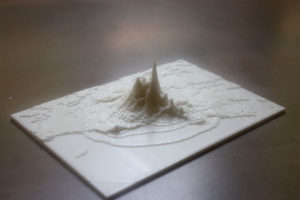Most of us have never experienced the terror of a major earthquake, but may have been surprised to feel tremors here or there—and sometimes in places where little activity is recorded. When a substantial quake strikes though, it can cause long-term devastation, racking up billions of dollars in damage. California, of course, is known for earthquake activity, and famous for the San Andreas fault, which runs for 600 miles from the southern end of the state just past San Francisco. With such high populations of people, not to mention buildings which could come toppling down, many worry about the future of such areas—and insurance companies stay one step ahead of the game with statistics, projections, and complex mapping.
Doug McCune works for a startup, SpatialKey, that caters to the insurance industry, so his interest in mapping natural disasters—to include earthquakes—has been longstanding. We marveled as McCune 3D printed USGS earthquake data several years ago after an earthquake in Napa.
Now, he is sharing his method for 3D printing an earthquake with everyone in an Instructables project. This should be popular with all the hobbyists out there with an affinity for fabricating topographical maps, with the twist of being able to see the data produced after an earthquake in 3D. The first step is to download a ShakeMap (the data which demonstrates the shake intensity of a quake) from the United States Geological Survey.
 McCune used the Southern California Northridge earthquake of 1994 as an example, while focusing on several earthquakes of historical significance.
McCune used the Southern California Northridge earthquake of 1994 as an example, while focusing on several earthquakes of historical significance.
Download the specific shapefilerecommended by McCune, and then unzip it as instructed.
“The shapefile download of an earthquake contains multiple shapefiles that represent different measurements of shaking,” states McCune. “PGA is peak ground acceleration, PGV is peak ground velocity, and MMI is Modified Mercalli Index. You can read about these various measurements. I’ll be converting the PGV map to a 3D model, but the same steps apply for any of the other shapefiles in the archive.”
Next, it is important to understand the data, with help from the designer, who uses QGIS for examining the shapefiles and looking at what are contour maps.
“The map is made up of a series of polygons, and each polygon has associated attributes,” says McCune. “The peak ground velocity is stored on each polygon as the VALUE attribute. If you color the shakemap by this value you can see how the shake intensity radiates out from the epicenter.”
Steps three and four of the Instructable walk you through downloading the correct node and understanding the command line terminal, as well as setting up the project directory. After that, you will need to set up your JavaScript file and then run it to create the .stl file for 3D printing. McCune mentions that you will not have to use supports for this print because the topography is ‘stacked’ straight up.
“The one caveat to printing maps like this with a large flat base: beware of the print lifting off the platform as it prints. PLA is typically a better material than ABS to ensure your print sticks to the build platform. A heated platform is recommended,” McCune notes.
Are you interested in 3D printing an earthquake? If so, check out McCune’s Instructable here.
Let us know your thoughts on this news. Join the discussion of this and other 3D printing topics at 3DPrintBoard.com or share your thoughts below.
[Images: Doug McCune via Instructables]
Subscribe to Our Email Newsletter
Stay up-to-date on all the latest news from the 3D printing industry and receive information and offers from third party vendors.
You May Also Like
Profiling a Construction 3D Printing Pioneer: US Army Corps of Engineers’ Megan Kreiger
The world of construction 3D printing is still so new that the true experts can probably be counted on two hands. Among them is Megan Kreiger, Portfolio Manager of Additive...
US Army Corps of Engineers Taps Lincoln Electric & Eaton for Largest 3D Printed US Civil Works Part
The Soo Locks sit on the US-Canadian border, enabling maritime travel between Lake Superior and Lake Huron, from which ships can reach the rest of the Great Lakes. Crafts carrying...
Construction 3D Printing CEO Reflects on Being Female in Construction
Natalie Wadley, CEO of ChangeMaker3D, could hear the words of her daughter sitting next to her resounding in her head. “Mum, MUM, you’ve won!” Wadley had just won the prestigious...
1Print to Commercialize 3D Printed Coastal Resilience Solutions
1Print, a company that specializes in deploying additive construction (AC) for infrastructure projects, has entered an agreement with the University of Miami (UM) to accelerate commercialization of the SEAHIVE shoreline...

































